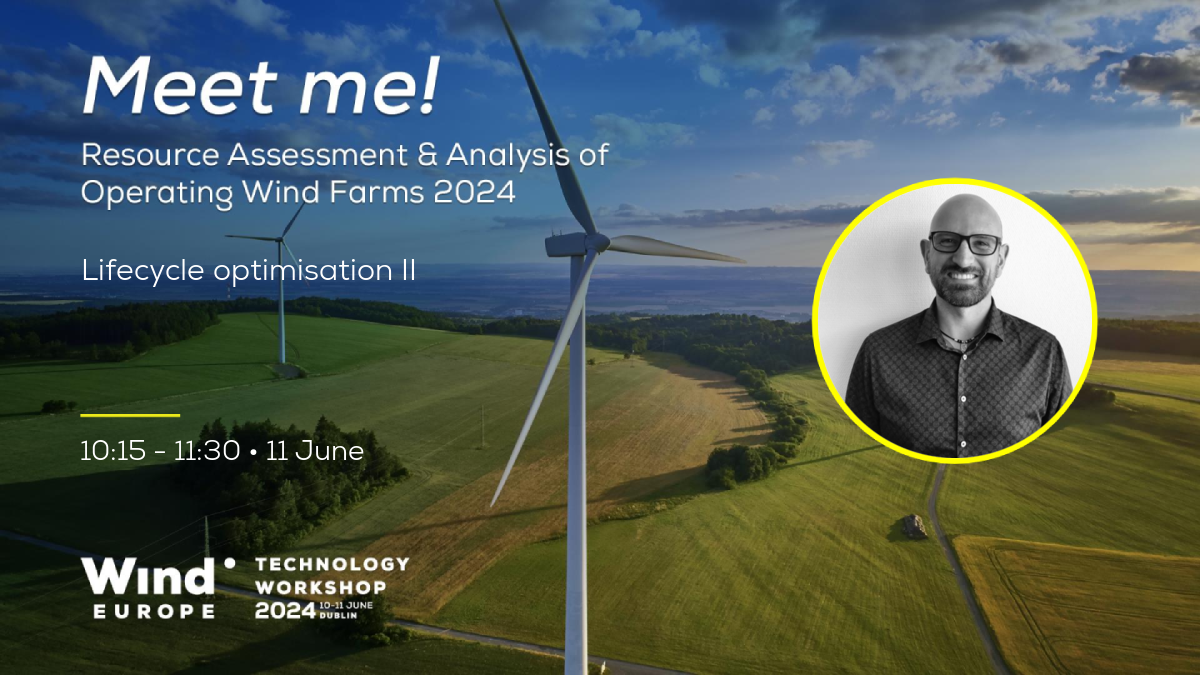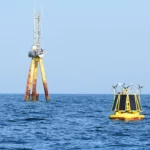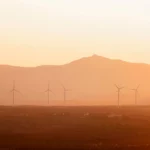← Return
WindEurope Technology Workshop : 3 posters and a conference session

Meteodyn will actively participate in the WindEurope Technology Workshop 2024, with 3 poster presentations and one conference session.
This year’s WindEurope Technology Workshop will be held on June 10-11, in Dublin. The workshop will focus on the Resource Assessment & Analysis of Operating Wind Farms.
Meteodyn will be represented by Eric Tromeur, Director of Research, Innovation, Service and Expertise Department and will actively participate, with 3 posters presentation and one conference session, both focusing on onshore and offshore topics.
A conference session on Lifecycle optimisation
On Tuesday, 11 June 2024, from 10:15 to 11:30 will be held a conference session on Lifecycle optimisation. In this session, we will explore strategies for extending the lifespan, improving the efficiency, and minimizing the environmental impact of wind turbine blades. We will examine how measurement techniques, data-driven methods, and models can be utilized to optimize the operations and maintenance of these blades.
Eric Tromeur will be taking part in this conference.
Applying wind turbine SCADA data in the early detection of harmful status codes: a novel approach using ANN
Abstract
With the fast development of renewable energy toward the Net-Zeros commitment, especially in wind energy, reducing the maintenance cost of wind turbine becomes more and more important. To anticipate wind turbine failures, several studies proposed installing a condition monitoring system, which is onerous and difficult to be implemented. In this study, an approach using only wind turbine SCADA data is considered using Artificial Neural Network. The objective of the study is to examine the feasibility of using SCADA data to detect the occurrence of harmful status codes before it happens. Read more ↘
3 poster presentations
PO111: Improving Wind Resource Modelling in Coastal Areas through Advanced CFD methods with Integration of Mesoscale Data
Presented by Ru Li, Senior Research Engineer at Meteodyn
Coastal regions offer an ideal environment for wind farms due to the consistent and strong winds that blow in from the sea. Coastal wind farms can achieve high energy yield because the sea breeze tends to be more consistent and stronger than inland winds, resulting in increased efficiency and a more reliable power supply. The expansive open spaces and proximity to populated areas make these locations attractive for the development of wind energy projects, leading to a growing trend in the construction of wind farms along coastal areas. To study wind flow in coastal regions, impacts from both microscale topography and regional climate conditions should be considered. These effects are coupled between them and can be correctly reproduced only with an appropriately designed model chain covering both microscale and mesoscale phenomena. In Meteodyn WT, the mesoscale-microscale coupling method combines mesoscale models which capture the climate conditions and introduce them in the micro-scale model, with microscale model that focus on the terrain complexity to improve the wind resource modelling at the coastal area. Read more and watch the video presentation ↘
PO058: Advancing offshore wind resource assessment: overcoming post-subsidy challenges in China through SARWind technology
Presented by Zixiao Jiang, Technical Director at Meteodyn China
China’s ambition for offshore wind power is not ceased by the renewable subsidy sunset, against the backdrop of the country seriously committing to achieve carbon-neutrality by 2060. Amidst this commitment lies a critical challenge: the high construction costs of offshore wind projects juxtaposed with declining feed-in tariffs underscore the necessity of precise wind resource estimation, commencing as early as the project’s preliminary planning phase. The swift pace of offshore wind energy development mandates an accurate knowledge of wind resources, often prior to on-site wind measurement campaigns, or only with measurement data from masts or floating lidars geographically removed from the area of interest. While mesoscale models span large areas, they fall short in capturing small-scale phenomena, leading to potentially substantial temporal and spatial errors—thus amplifying risks during the project planning and design stages. In response, this study spotlights an escalating interest in leveraging satellite data to refine offshore wind speed assessments. We present the SARWind methodology, which utilizes synthetic aperture radar (SAR) data in conjunction with specialized machine learning algorithms and atmospheric models. Read more and watch the video presentation ↘
PO044: Applying wind turbine SCADA data in the early detection of harmful status codes: a novel approach using ANN
Presented by Minh-Thang Do, Technical Manager of Renewable Energy at Meteodyn North America
With the fast development of renewable energy toward the Net-Zeros commitment, especially in wind energy, reducing the maintenance cost of wind turbine becomes more and more important. To anticipate wind turbine failures, several studies proposed installing a condition monitoring system, which is onerous and difficult to be implemented. In this study, an approach using only wind turbine SCADA data is considered using Artificial Neural Network. The objective of the study is to examine the feasibility of using SCADA data to detect the occurrence of harmful status codes before it happens. The SCADA data of each wind turbine consists of several years of measurements such as temperature, wind speed, power from various sensors and control systems. This data is usually archived as time series, with 10-minute time step. Though, the status codes of the machine bringing information about the operation state are usually archived in the form of an event log. The data preparation consists of formatting, cleansing the SCADA data, converting the status code event log into time series, and synchronizing the 2 datasets. Read more and watch the video presentation ↘


